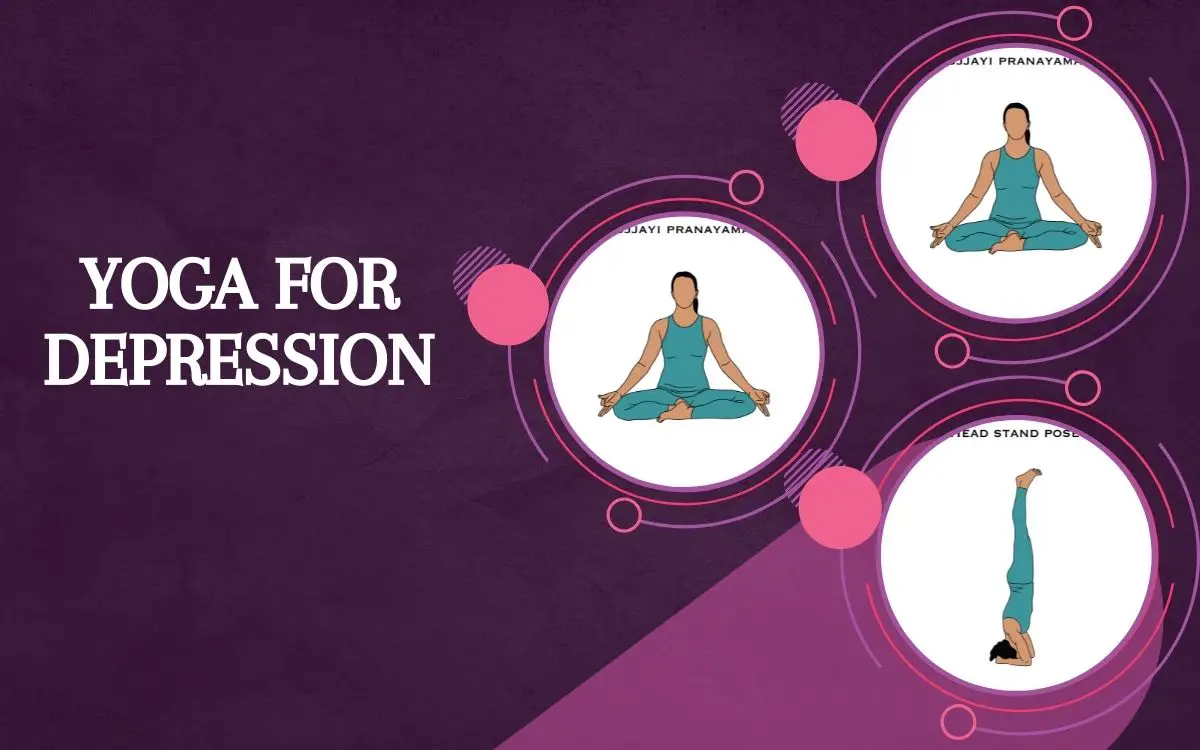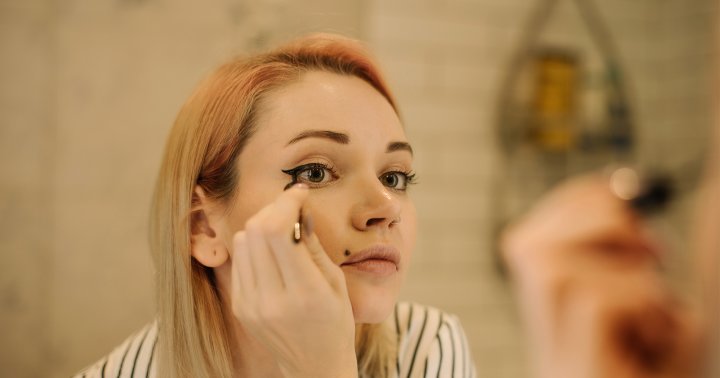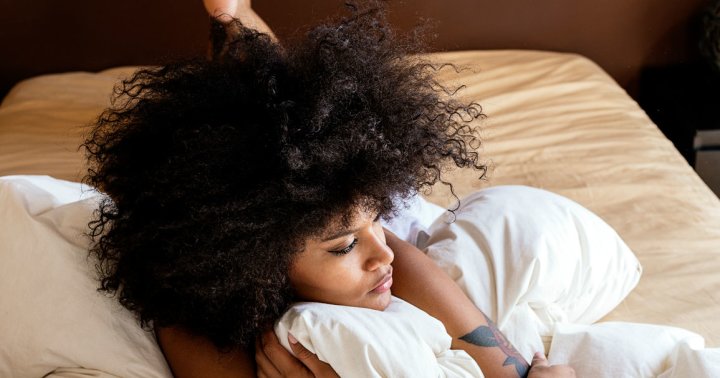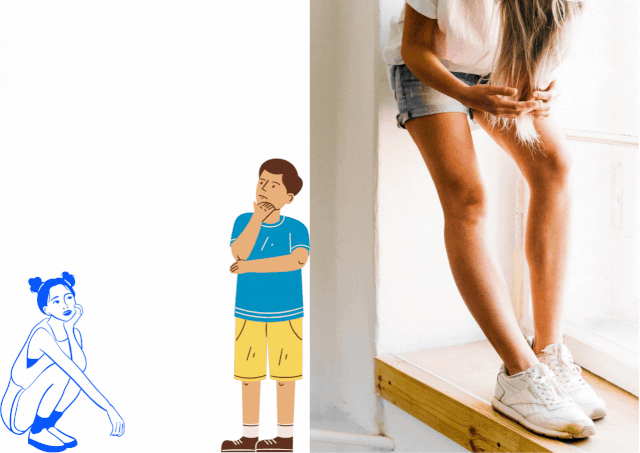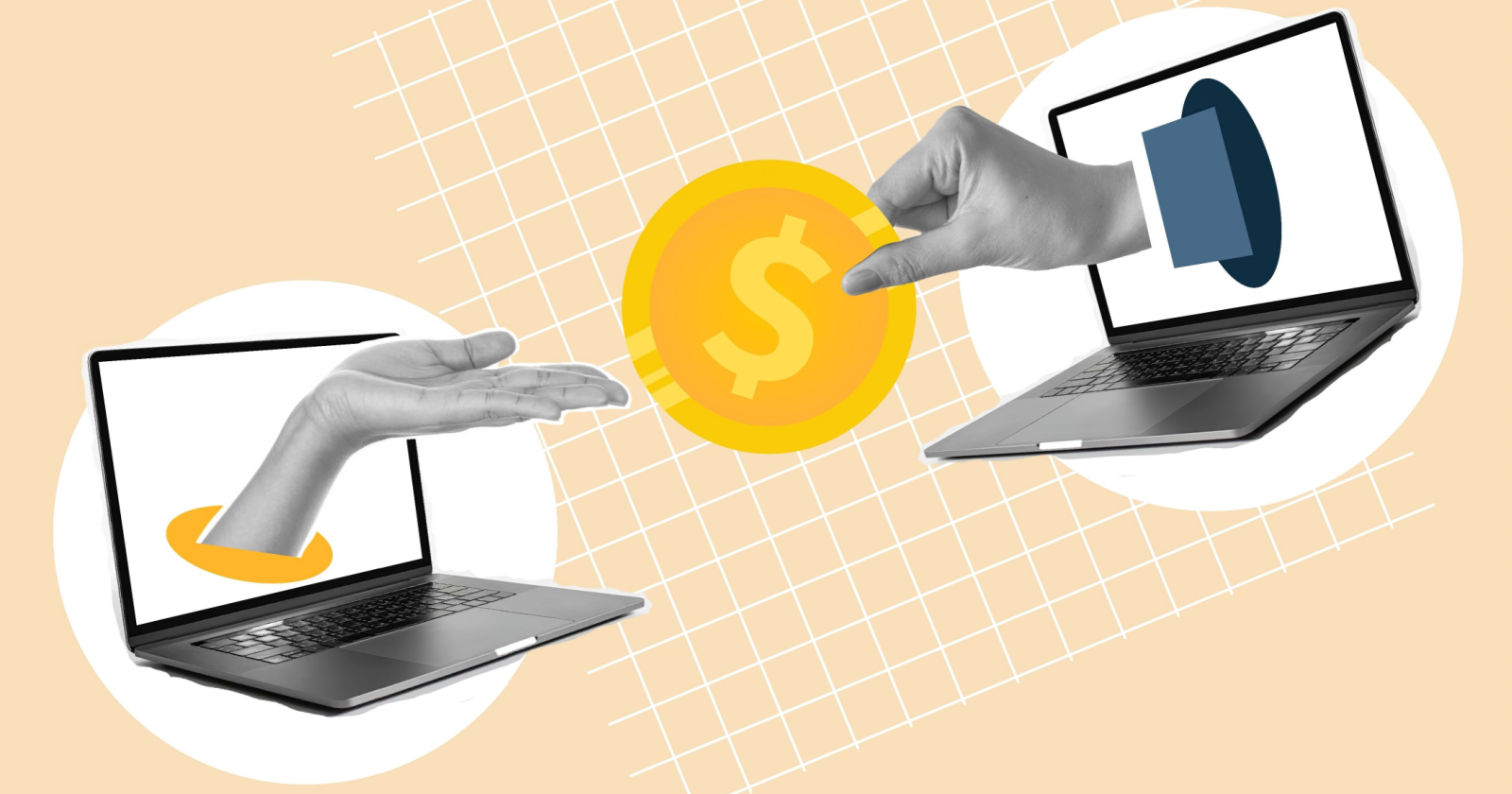Shalabasana Mastery: Your Ultimate Guide to Perfecting the Locust Pose
The post Shalabasana Mastery: Your Ultimate Guide to Perfecting the Locust Pose appeared first on The Yoga Nomads.

In today’s tech-focused world, hunched backs and rounded shoulders are an unfortunate and all-too-common product of our increasingly sedentary lives. S many of us work online in front of a screen these days — even me, a yoga teacher!
Many of my students arrive to class with tales of discomfort, seeking solace from the notorious office chair slump. In that case, when I hear laments of sore backs or painful necks, there’s one pose I know I’ll include in that day’s flow: shalabasana, commonly known as locust pose.
Shalabasana is a secret weapon against lower back pain and poor posture, not to mention a full-body workout! This powerhouse of a pose works your back muscles, core, glutes, and legs, helping you build strength for many other yoga postures. Plus, the backbend element of Shalabasana helps counteract the effects of sitting hunched over for too many hours.
If you’ve been slumped over a desk, slouching while scrolling on your phone, or just feeling the world’s weight on your shoulders, this fantastic asana might be your ticket to relief.
Ready to straighten your scrunched spine and wake up your weary back muscles? Roll out your yoga mat and join me on a journey to a healthier, happier back.
All About Shalabasana
Shalabasana (also spelled salabhasana) is a traditional asana with roots deeply embedded in ancient practices. It comes from the Sanskrit word salabha, meaning “locust.”
This asana is significant in yoga history since its first mention in the 17th-century text, the Gheranda Samhita. The enduring effectiveness of this pose is evident by its widespread use in various modern yoga styles. You’re likely to encounter Shalabasana:
As one of the 26 yoga poses in the Bikram series included in the backbends of Ashtanga’s second series In the Iyengar system, which emphasizes proper alignment, bringing awareness to the spine’s position in each pose. in many core-strengthening and backbend-focused yoga sequencesThe popularity of this pose across styles also demonstrates its versatility. Whether you’re a seasoned yogi working through the intermediate Ashtanga series, rehabilitating from an injury with a prop-supported Iyengar practice, or a newbie working up to more challenging backbends, Shalabasana is an essential addition to your repertoire of yoga postures.
Shalabasana Step-by-Step Guide
This pose is all about alignment! Make sure you’re engaging all the correct muscles by following these steps.
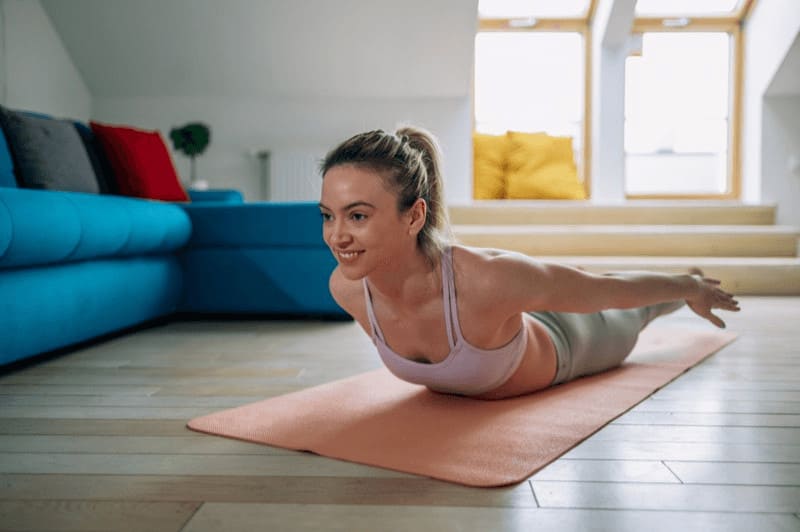
Starting Position
Begin in advasana or belly savasana:
Lie flat on your stomach with your face turned to one side, resting one cheek on the floor. Extend your legs behind you, tops of your feet on the floor. Bring your hands by your sides, palms facing up.Moving into Locust Pose
Turn your head and tuck your chin slightly, bringing your forehead to your mat. Engage the muscles of your abdomen by pressing your navel in towards your spine. Inhale and lift your head, upper body, arms, and legs off the floor simultaneously. As your arms reach behind you, turn your palms to face each other. Pull up on your kneecaps to engage the muscles in your thighs. Squeeze your legs, bringing your big toes together. Fix your gaze on the floor slightly ahead of you, keeping length in the back of the neck. Hold the pose for 3 to 7 breaths as you are able.Exiting the Pose Safely
To exit Shalabasana:
Exhale and gently lower your legs, arms, and upper body to the floor. Turn your face to the side and carefully place one cheek on your mat. Rotate your arms and place the backs of your hands on the ground.Counterposes to Relax After Shalabasana
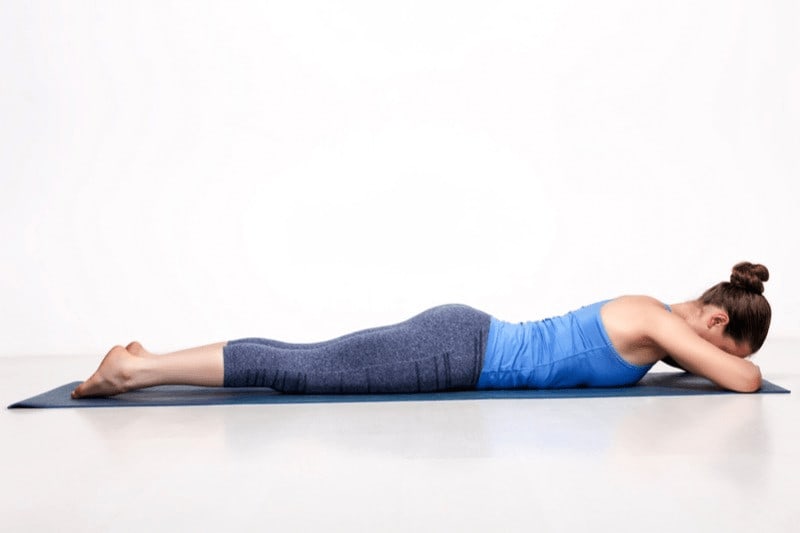
After Shalabasana, give yourself a well-deserved rest with these relaxing poses.
Crocodile Pose: as you lower down from Shalabasana, bring your hands forward and bend your elbows. Stack one forearm on the other and rest your forehead on your top arm. Child’s Pose: after lowering from Shalabasana, place your hands underneath your shoulders and press backward, bringing your hips onto your heels. Keep your forehead on your mat and bring your hands by your sides, palms facing up.These restful yoga postures help release any tension in the back or neck after Shalabasana.
Techniques for Mastering Shalabasana
Breath control and the use of props are beneficial when practicing Shalabasana. When used properly, these tools can take your pose to new heights.
The Breath Control Factor
Shalabasana requires full-body engagement to hold the position. In this case, you might be tempted to hold your breath while lifting into the pose. Instead, try to keep your breaths steady and even, flowing in and out.
Coordinate your breaths with your movements as you enter, hold, and exit Shalabasana.
Inhale to lift into Shalabasana. Hold the position for 30 seconds or so as your breath flows. Finally, exhale and lower down to your mat.Using Props
Props can be lifesavers for beginners or those with limitations. For instance:
Use a folded blanket under your hips to provide more comfort. Place a block under your forehead to avoid straining your neck. Set up with your feet touching a wall. As you lift into the pose, press the balls of your feet against the wall for support and balance.Level-Up Your Locust Pose
Once you’ve got the hang of it, it’s time to level up. Here are some tips:
Squeeze a block between your thighs for an extra leg workout. Clasp your hands behind you for an extra shoulder and chest opening effect. Use your inhales to squeeze and lift an inch higher on each breath.Make sure you’re ready for any modifications by picking up a set of Manduka yoga blocks!

Cork Yoga Blocks 2 Pack Set -Natural Cork from Portugal, 9"x6"x4" Yoga Blocks Non-Slip&Anti-Tilt for...
Common Alignment Mistakes to Avoid
Watch out for these common mistakes in Shalabasana. If you’re a yoga teacher, remind your students of these vital alignment cues.
Avoid looking straight ahead: keep the gaze on the floor to avoid compressing the neck. Keep your chin slightly tucked. Even though you’re balancing on your abdomen, don’t forget to keep your core engaged.Variations of Shalabasana
One of my favorite things about Shalabasana as a yoga teacher is the many variations, making this asana accessible, versatile, challenging, and creative!
Half-Shalabasana
Ardha (Half) Shalabasana is perfect for beginners or yogis recovering from an injury. You’ll still target your back muscles with less risk of straining.
Begin in the same way as regular Shalabasana, lying on your stomach. Lift your upper body, arms, and one leg. Keep your grounded leg pressing into the floor. Hold for a breath, then lower down as you exhale. Repeat Ardha Shalabasana with your other leg lifted.
Superman Pose
This variation is quite similar to Shalabasana, with a slight change in the arm position. In Superman Pose, reach both hands forward as you lift into the pose.
Skydiver Pose
Check out this modern twist on Shalabasana — the Skydiver Pose. Picture yourself free-falling from an airplane (but safely on your mat).
Set up in the same way as regular Shalabasana, with your legs separated to about hip-width distance. As you lift into the pose, bend your knees and flex your feet. Open your arms wide and bend your elbows into a goalpost shape as you raise your torso off the floor.
This is a fun twist to traditional variations and a great way to change up your routine.
Bikram Style
Lastly, let’s talk about the Bikram style of Shalabasana, which has a distinct way of practicing Shalabasana.
In this variation, your upper body stays on the floor. Bring your hands underneath your pelvis, pinky fingers touching, and palms on the ground. Keep your forehead pressing into your mat as you lift your legs as high as possible.
Even if Bikram isn’t your typical style, adding variations like this can give you a new perspective on familiar poses.
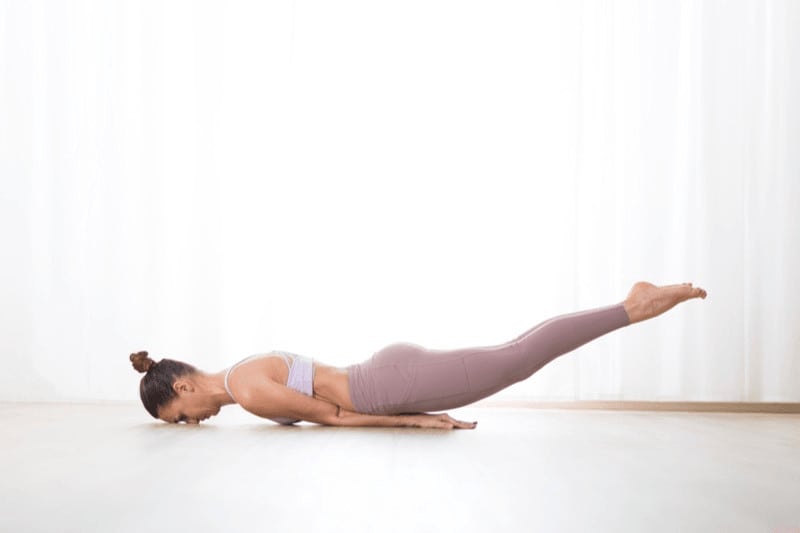
Benefits of Shalabasana
When introducing Shalabasana, we mentioned a few of its physical perks. Let’s take a closer look at the anatomy of the pose and further unpack its many benefits.
Strengthens Lower Back, Buttocks, and Thighs
Shalabasana is a workout for many major muscles. This pose targets the lower back, buttocks, and thighs. Practicing Shalabasana regularly can help you build strength to support you in all other yoga postures. Here’s a look at the anatomy of Shalabasana.
Tones back muscles: Shalabasana exercises the lumbar muscles and is effective in relieving chronic lower back pain Strengthens glutes, thighs, and hamstrings Engages the core muscles Lengthens and strengthens the hip flexorsImproves Postural Alignment and Spinal Health
Did you know back pain affects an estimated 12% of the world’s population — one in every eight people? If you’re lucky enough never to deal with chronic aches and pains, make sure you stay that way by adding Shalabasana into your regular rotation of poses.
Here are several ways Shalabasana helps keep your back strong and healthy.
Aligns spine and improves mobility: In a study of arthritis patients, shalabasana was one of several key yoga poses that improved spinal flexibility. Correct posture: Studies report a high instance of neck pain in adolescents who use a computer just 9 hours per week — imagine the professionals who work 40 hours! Locust Pose can help reverse this “text neck” by strengthening and lengthening the neck. Alleviates back pain: A 12-week hatha yoga intervention that included shalabasana demonstrated effectiveness in reducing discomfort and the need for medicationFosters Stress Relief Through Focused Breathing
This pose demands focused breath and concentration, which promotes stress relief.
Deep breathing stimulates the parasympathetic nervous system Focus on alignment and breath builds concentration Breath awareness calms the mindWhether you want to tone your body or calm your mind, Shalabasana has got you covered. Remember to breathe deeply as you hold the pose and let go of any tension in your body.

Incorporating Shalabasana into Your Routine
Shalabasana, or the Locust Pose, is a foundational pose in Hatha Yoga, subsequently adopted by several modern styles due to its versatility.
This pose targets your upper body, particularly your back muscles, which will help support your progression in other challenging poses. For example, if you aim to achieve impressive backbends like Wheel or Dancer or inversions like Scorpion, then Shalabasana is a fantastic place to start!
Here are some other ways I like to incorporate Shalabasana in my classes:
Backbend warmup: If you plan to include backbends like Camel or Bow in your session, do a few rounds of Shalabasana first. Core strengthening: Since Shalabasana also tones the core, it works well with poses like Plank, Forearm Plank, and Dolphin. Try putting these yoga poses together in a mini-sequence! Heart and shoulder opening flows: Add the shoulder-opening variation of Shalabasana to a sequence with poses like Thread the Needle, Puppy, Bridge, and Wild Thing for a heart-chakra-inspired session.Now it’s time to get creative! Use the suggestions above to have some fun on your mat with Shalabasana.
Final Thoughts on Shalabasana
Shalabasana is a surprisingly challenging but rewarding pose that keeps you strong and agile and strengthens every aspect of your yoga practice. That’s one of the reasons I love this versatile asana — you can seamlessly add it to many types of sequences.
On top of that, we can’t ignore the fact that many of us need to show our backs a little TLC. The prevalence of postural issues like “text neck” and chronic aches and pains is on the rise as more and more of us work in front of screens.
Once you start practicing Shalabasana regularly, you’ll notice improved spinal alignment on and off your mat. I’m biased, being a yoga teacher, but I think anyone can benefit from learning to do Shalabasana as part of their exercise routine, whether they do yoga or not.
This complete guide gives you all the information needed to start now. Your spine will thank you!
FAQ 1: Is Shalabasana suitable for beginners?
Yes, Shalabasana is suitable for beginners. However, they should start with the simple variations before moving on to more complex ones as their flexibility and strength improve.
FAQ 2: Can I practice Shalabasana during pregnancy?
No. If you’re pregnant, skip Shalabasana since it places too much pressure on the abdomen. Always consult your healthcare provider before performing any new exercises while pregnant.
FAQ 3: What are the positive effects of practicing Shalabasana?
Shalabasana strengthens the lower back muscles, improves posture, enhances flexibility, stimulates abdominal organs, and promotes stress relief.
FAQ 4: How often should I practice Shalabasana?
For optimal results, aim to incorporate Shalabasana into your regular exercise routine. Aim for at least 3 weekly sessions, with a few rounds of Shalabasana each time. Frequent practice will help enhance all of its positive physical and mental effects.
FAQ 5: Do I need to take any precautions while performing Shalabasana?
Avoid this pose if you have severe pain in your neck or back, Sciatica, or a related injury like slipped or herniated discs. It’s always best to consult with a healthcare professional if you’re unsure.

 JaneWalter
JaneWalter 








